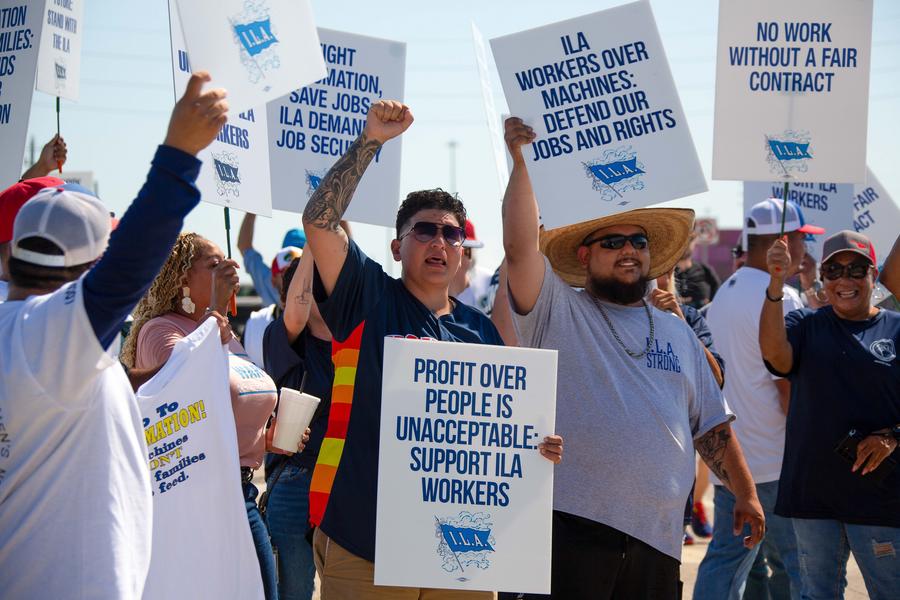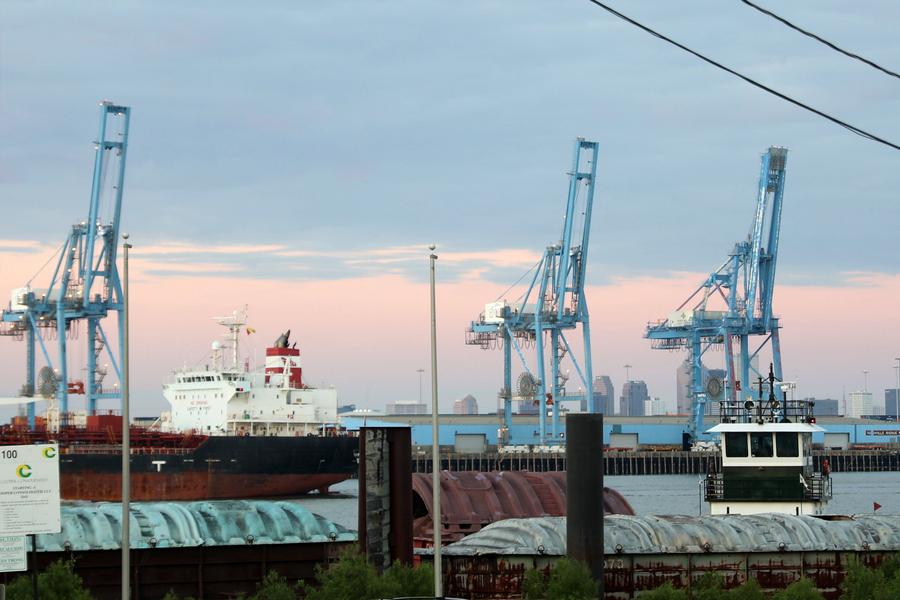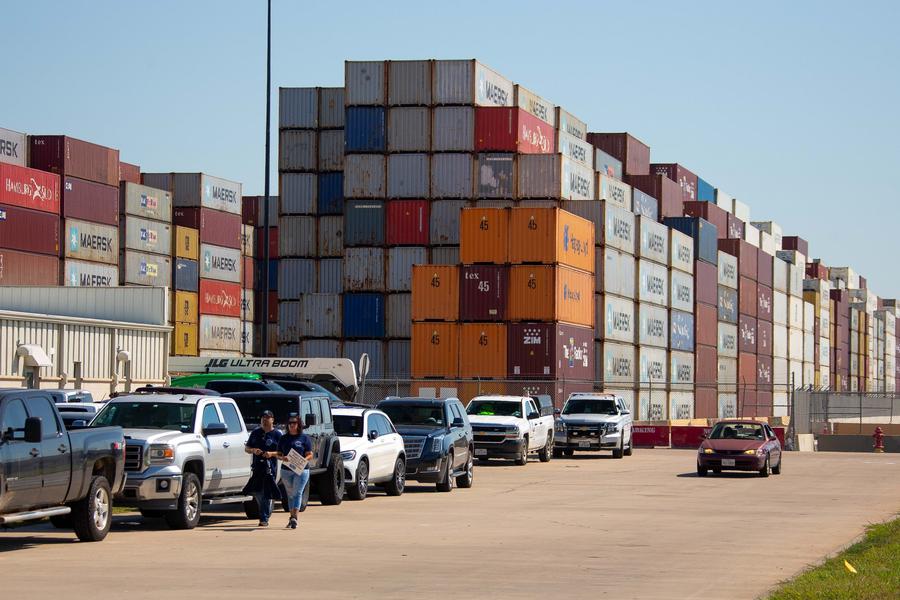Port strikes reveal longstanding U.S. plight on industry upgrade

Port workers participate in a strike at the Port Houston in Texas, the United States, on Oct. 1, 2024. (Photo by Chengyue Lao/Xinhua)
"Automation creates value. It makes the pie bigger. And in theory that should be, there should be room for a win-win there," said Erik Brynjolfsson, the director of Stanford University's Digital Economy Lab.
NEW YORK, Oct. 17 (Xinhua) -- As U.S. port workers and operators representing big companies reached tentative deals on wage raises, a massive strike involving workers on the U.S. East and Gulf Coasts has ended, but the legal tussle is far from over, and automation is expected to become the next sticking point.
Labor unions, for fear that workers' jobs would be replaced by machines, have long resisted port automation through strikes and other measures.
Operators, on the other hand, are worried that labor disputes will further push up operating costs, hoping to reduce their dependence on labor and promote automation.
Against the background of entanglement between the two sides, U.S. ports have missed the opportunity for technological innovation, resulting in a widening gap in operational efficiency compared with other countries, while the massive strikes have caused huge losses to the supply chain and the U.S. economy.
COSTS VS LIVELIHOOD
The long-standing labor disputes at U.S. ports have primarily revolved around two key issues: wage levels and port automation. For dockworkers and unions, wages are essential for their livelihoods, while automation poses a threat to job security. As a result, major technological upgrades in U.S. ports have often sparked intense labor conflicts.
A notable example dates back to the 1950s when cargo handling was labor-intensive, time-consuming, and fraught with risks. Unions held significant influence over port operations, and employers were frequently compelled to pay high wages to avoid strikes. This dynamic only began to change with the advent of containerization, which drastically reduced both loading time and labor demand.

This photo shows the Port of New Orleans in Louisiana, the United States, on Oct. 1, 2024. (Photo by Lan Wei/Xinhua)
Malcom McLean, the inventor of the modern shipping container, said that in 1956, the labor cost to load a medium-sized ship was 5.83 U.S. dollars per ton. With the introduction of containers, this cost plummeted to just 16 cents per ton, with most of the savings coming from reduced labor expenses.
Driven by the need to cut costs, port operators, often representing large corporations, have consistently pushed for technological upgrades and automation.
As containerization spread, the number of dockworkers steadily declined, intensifying the conflict between cost-cutting measures and job security. In the most recent labor disputes at U.S. ports, labor unions have not only demanded wage increases but also called for a "total ban on automation," including semi-automation that could reduce or replace manual labor.
Earlier this month, the International Longshoremen's Association reached a tentative agreement with the United States Maritime Alliance, which represents the port operators, to suspend the strike.
The agreement includes a 62-percent wage increase for workers but leaves unresolved the contentious issue of banning automated machinery, which will be a key focus in the next round of negotiations.
INNOVATION VS CONVENTION
The recent strike has further exposed the level of port automation in the United States. The Wall Street Journal used "bad" to describe the operational efficiency of American ports, and economists have deemed American ports to be "backward."
The World Bank's Container Port Performance Index 2023 shows that there is not a single U.S. port in the top 50 in terms of port efficiency. The Charleston port in South Carolina was the highest-ranked U.S. port, only coming in at 53rd place.
Many experts believe that automation can help U.S. ports improve efficiency, security and solve supply chain problems. However, such an upgrade has faced many obstacles.
Labor unions believe that technological progress may threaten workers' jobs. For instance, ports in Los Angeles and Long Beach handle as much as 40 percent of the nation's imports and exports. However, about five percent of 13,000 jobs were replaced due to increased automation.

Port workers participate in a strike at the Port Houston in Texas, the United States, on Oct. 1, 2024. (Photo by Chengyue Lao/Xinhua)
The Wall Street Journal (WSJ) said in a recent opinion piece that port workers "don't want any technological advances that would make loading and unloading ships faster, safer and more efficient -- e.g., smarter cranes, gates, and container-moving trucks that require fewer workers to operate."
"In other words, they want higher pay with no productivity gains, which is unsustainable in a competitive global economy," it added.
In fact, concerns over replacing workers with technology have existed since the Industrial Revolution, while "the fight against productivity is a losing battle," said the WSJ.
The labor entanglement put both sides in trouble: U.S. ports have failed to realize automation, lagging behind in terms of overall level of port technology; yet dockworkers, who fiercely defended their jobs, cannot stop the inevitable trend of technological upgrading.
SHORT-TERM IMPACTS VS LONG-TERM LOSSES
Is the contradiction between technological advancement and job positions truly unsolvable? Many experts believe that innovation can enhance efficiency while expanding the overall economic pie, compensating for job losses and benefiting relevant parties.
However, in the recent U.S. port strike, many only focused on the short-term negative impacts of automation, failing to see the value of technological progress.
"I find it very short-sighted of the dockworkers, or any workers, to be pushing against automation if you can instead find a way that the gains get shared," The Hill reported, citing Erik Brynjolfsson, the director of Stanford University's Digital Economy Lab.
Emphasizing that the United States' ports are "dramatically under-automated," Brynjolfsson said the increase could stand to benefit workers, consumers and companies.
"Automation creates value. It makes the pie bigger. And in theory that should be, there should be room for a win-win there," he told The Hill.
The strike organized by labor unions to resist automation aims to protect the interests of thousands of dockworkers, while it could harm the jobs of millions of American workers outside the ports and negatively impact the U.S. economy.
J.P. Morgan has estimated earlier that port strikes would cost the U.S. economy up to 5 billion U.S. dollars a day. Additionally, the diversion of goods caused by strikes could exacerbate congestion at other ports, leading to delays, supply chain strain, and significant increases in freight costs.
The U.S. government has been cautious in addressing the labor dispute just weeks before the presidential election, prioritizing votes over potential economic losses.
Since union voters are key to the Democratic Party, U.S. President Joe Biden said he would not use a federal labor law to force the workers back to work, although he has the authority to end the strike and contain larger economic pain.
If the tentative agreement between the dockworkers and port operators cannot be turned into a long-term contract, the risk of further strikes will continue to cast a shadow over the U.S. economy.
Photos
Related Stories
- Ukrainian, U.S. presidents discuss defense issues over phone
- Pandas Bao Li and Qing Bao in good shape at Smithsonian's National Zoo
- Election betting markets in U.S. gain traction amid concerns
- News Analysis: Hurricane-induced IV fluid shortage exposes U.S. supply chain vulnerabilities
- U.S. hospitals struggle as storms worsen medical products shortages
Copyright © 2024 People's Daily Online. All Rights Reserved.









